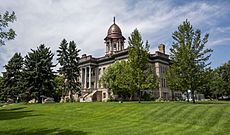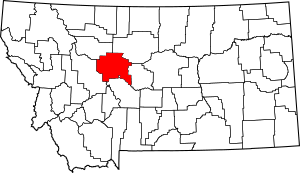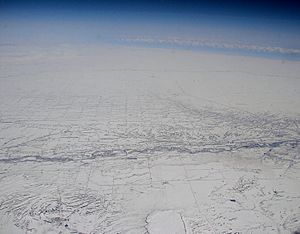Cascade County, Montana facts for kids
Quick facts for kids
Cascade County
|
|
|---|---|

Cascade County Courthouse
|
|

Location within the U.S. state of Montana
|
|
 Montana's location within the U.S. |
|
| Country | |
| State | |
| Founded | 1887 |
| Named for | Great Falls of the Missouri River |
| Seat | Great Falls |
| Largest city | Great Falls |
| Area | |
| • Total | 2,711 sq mi (7,020 km2) |
| • Land | 2,698 sq mi (6,990 km2) |
| • Water | 13 sq mi (30 km2) 0.5% |
| Population
(2020)
|
|
| • Total | 84,414 |
| • Estimate
(2022)
|
84,864 |
| • Density | 31.138/sq mi (12.0223/km2) |
| Time zone | UTC−7 (Mountain) |
| • Summer (DST) | UTC−6 (MDT) |
| Congressional district | 2nd |
|
|

Cascade County (cascade means waterfall in French) is a county located in the U.S. state of Montana. As of the 2020 census, the population was 84,414, making it the fifth-most populous county in Montana. Its county seat is Great Falls.
Cascade County comprises the Great Falls, MT Metropolitan Statistical Area.
Contents
History
At the time of the Lewis and Clark Expedition, Cascade County was the territory of the Blackfeet. The county was named for the falls on the Missouri River.
The United States Army once had Fort Shaw as an outpost in the northwest part of the county. Only a small settlement, a CDP, remains by that name.
Geography
According to the United States Census Bureau, the county has a total area of 2,711 square miles (7,020 km2), of which 2,698 square miles (6,990 km2) is land and 13 square miles (34 km2) (0.5%) is water. The Missouri River and the Sun River flow through the county, and meet at the city of Great Falls. A portion of the Adel Mountains Volcanic Field is in the county's southwest corner. The Rocky Mountains are in the western part of the county, with the Little Belt and Highwood Mountains in the southeast.
Adjacent counties
- Teton County - northwest
- Chouteau County - northeast
- Judith Basin County - east
- Meagher County - south
- Lewis and Clark County - west
National protected areas
- Benton Lake National Wildlife Refuge
- Lewis and Clark National Forest (part)
Demographics
| Historical population | |||
|---|---|---|---|
| Census | Pop. | %± | |
| 1890 | 8,755 | — | |
| 1900 | 25,777 | 194.4% | |
| 1910 | 28,833 | 11.9% | |
| 1920 | 38,836 | 34.7% | |
| 1930 | 41,146 | 5.9% | |
| 1940 | 41,199 | 0.1% | |
| 1950 | 53,027 | 28.7% | |
| 1960 | 73,418 | 38.5% | |
| 1970 | 81,804 | 11.4% | |
| 1980 | 80,696 | −1.4% | |
| 1990 | 77,691 | −3.7% | |
| 2000 | 80,357 | 3.4% | |
| 2010 | 81,327 | 1.2% | |
| 2020 | 84,414 | 3.8% | |
| 2022 (est.) | 84,864 | 4.3% | |
| U.S. Decennial Census 1790–1960, 1900–1990, 1990–2000, 2010–2020 |
|||
2020 census
As of the 2020 census, 84,414 people were living in the county.
2010 census
As of the 2010 census, 81,327 people, 33,809 households, and 21,403 families in the county. The population density was 30.1 inhabitants per square mile (11.6/km2). There were 37,276 housing units at an average density of 13.8 per square mile (5.3/km2). The county's racial makeup was 89.2% white, 4.3% American Indian, 1.2% black or African American, 0.8% Asian, 0.1% Pacific Islander, 0.6% other races, and 3.6% from two or more races. Those of Hispanic or Latino origin made up 3.3% of the population. In terms of ancestry, 28.5% were German, 17.1% were Irish, 12.3% were English, 10.3% were Norwegian, and 4.5% were American.
Of the 33,809 households, 29.8% had children under the age of 18 living with them, 48.4% were married couples living together, 10.2% had a female householder with no husband present, 36.7% were non-families, and 30.5% of all households were made up of individuals. The average household size was 2.33 and the average family size was 2.90. The median age was 38.9 years.
The median income for a household in the county was $42,389, and the median income for a family was $53,540. Males had a median income of $37,904 versus $27,944 for females. The per capita income for the county was $22,963. About 10.9% of families and 13.5% of the population were below the poverty line, including 20.4% of those under age 18 and 8.8% of those age 65 or over.
Economy
Malmstrom Air Force Base is a driving force in the regional economy. In 2009, Benefis, Great Falls Clinic, National Electronics Warranty and Walmart were the largest private employers.
Education
The Apollos University, the University of Great Falls, and the MSU College of Technology—Great Falls are all located in Great Falls.
K-12 education
Public school districts include:
Secondary:
- Belt High School District
- Cascade High School District
- Great Falls High School District
- Simms High School District
- Centerville High School District
Elementary:
- Belt Elementary School District
- Centerville Elementary School District
- Cascade Elementary School District
- Great Falls Elementary School District
- Sun River Valley Elementary School District
- Ulm Elementary School District
- Vaughn Elementary School District
There is also a state-operated school, Montana School for the Deaf & Blind.
Communities
City
- Great Falls (county seat)
Towns
Census-designated places
- Big Stone Colony
- Black Eagle
- Cascade Colony
- Centerville
- Fair Haven Colony
- Fort Shaw
- Gibson Flats
- Hardy
- Malmstrom AFB
- Monarch
- Pleasant Valley Colony
- Riceville
- Sand Coulee
- Simms
- Stockett
- Sun Prairie
- Sun River
- Tracy
- Ulm
- Vaughn
Unincorporated communities
- Adel
- Armington
- Armington Junction
- Ashuelot
- Dearborn (partially within Lewis & Clark County)
- Eden
- Emerson Junction
- Gordon
- Millegan
- Number Seven
- Salem
- Sheffels
- Portage
See also
 In Spanish: Condado de Cascade para niños
In Spanish: Condado de Cascade para niños

